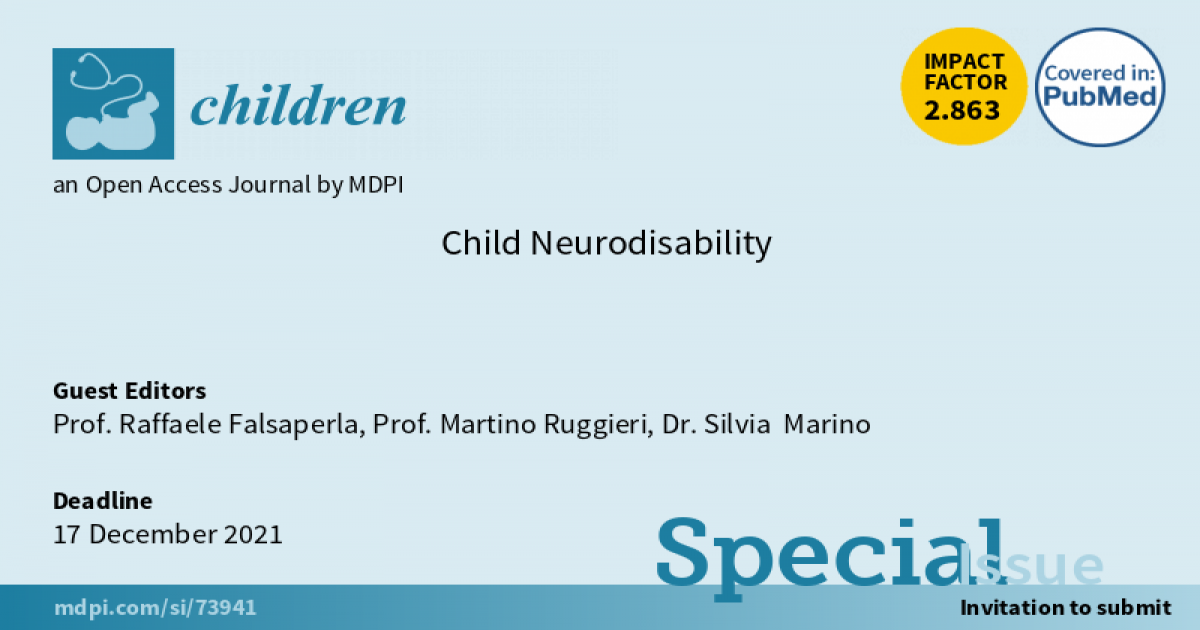- 2.1Impact Factor
- 3.8CiteScore
- 16 daysTime to First Decision
Child Neurodisability
This special issue belongs to the section “Pediatric Neurology & Neurodevelopmental Disorders“.
Special Issue Information
Dear Colleagues,
Many child-onset chronic health conditions are associated with functional limitations (traditionally referred to as “disabilities”). Some authors use the term neurodisability to refer to “a group of congenital or acquired long-term conditions that are attributed to impairment of the brain and/or neuromuscular system that create functional limitations, including difficulties with movement, cognition, hearing and vision, communication, emotion, and behavior”.
Historically, this population has been variably referred to as children with neurodevelopmental disorders or with neurodevelopmental disabilities, with these two terms often used interchangeably. However, it is important to differentiate the terms “disability” and “disorder”. Children with neurological pathologies imply a deep knowledge of the disease, related disorders, and possible complications with multidisciplinary management. Furthermore, neurodisability in children negatively impacts the family by lowering their quality of life.
The goal of this Special Issue of Children is to describe the early identification of neurological diseases for a precocious and targeted therapeutic intervention, for adequate management, and, finally, for a better outcome and better life quality in family members. Usually, it is assumed that in the pediatric age, brain plasticity is maximum, resulting in a better prognosis; however, the possibility of reducing the severity of symptomatic expression and functional relapses is not always as strong as expected. Increased knowledge of the biological basis and pathogenetic mechanisms of neurogenetic and neurometabolic diseases has led to an increase in clinical areas in which there are real possibilities to favorably affect early diagnosis, treatment, and sometimes even prevention of neurological disorders: already in some rare and multisystemic diseases, targeted and personalized therapies are able to modify the path of the disease itself and thus prevent severe secondary neurodisabilities. Today, evidence is being issued of the efficacy of targeted interventions in asymptomatic or paucisymptomatic children that appear to prevent or modify the trajectories of potential development of neurodisability.
Prof. Raffaele Falsaperla
Prof. Martino Ruggieri
Dr. Silvia Marino
Guest Editors
Manuscript Submission Information
Manuscripts should be submitted online at www.mdpi.com by registering and logging in to this website. Once you are registered, click here to go to the submission form. Manuscripts can be submitted until the deadline. All submissions that pass pre-check are peer-reviewed. Accepted papers will be published continuously in the journal (as soon as accepted) and will be listed together on the special issue website. Research articles, review articles as well as short communications are invited. For planned papers, a title and short abstract (about 250 words) can be sent to the Editorial Office for assessment.
Submitted manuscripts should not have been published previously, nor be under consideration for publication elsewhere (except conference proceedings papers). All manuscripts are thoroughly refereed through a single-blind peer-review process. A guide for authors and other relevant information for submission of manuscripts is available on the Instructions for Authors page. Children is an international peer-reviewed open access monthly journal published by MDPI.
Please visit the Instructions for Authors page before submitting a manuscript. The Article Processing Charge (APC) for publication in this open access journal is 2400 CHF (Swiss Francs). Submitted papers should be well formatted and use good English. Authors may use MDPI's English editing service prior to publication or during author revisions.
Keywords
- Children
- Newborns
- Nervous system
- Neruodisability
- Neurological involvement
- Epilepsy
- Rehabilitation
- Cerebral palsy
- Craniostenosis
- Microcephaly

Benefits of Publishing in a Special Issue
- Ease of navigation: Grouping papers by topic helps scholars navigate broad scope journals more efficiently.
- Greater discoverability: Special Issues support the reach and impact of scientific research. Articles in Special Issues are more discoverable and cited more frequently.
- Expansion of research network: Special Issues facilitate connections among authors, fostering scientific collaborations.
- External promotion: Articles in Special Issues are often promoted through the journal's social media, increasing their visibility.
- e-Book format: Special Issues with more than 10 articles can be published as dedicated e-books, ensuring wide and rapid dissemination.

